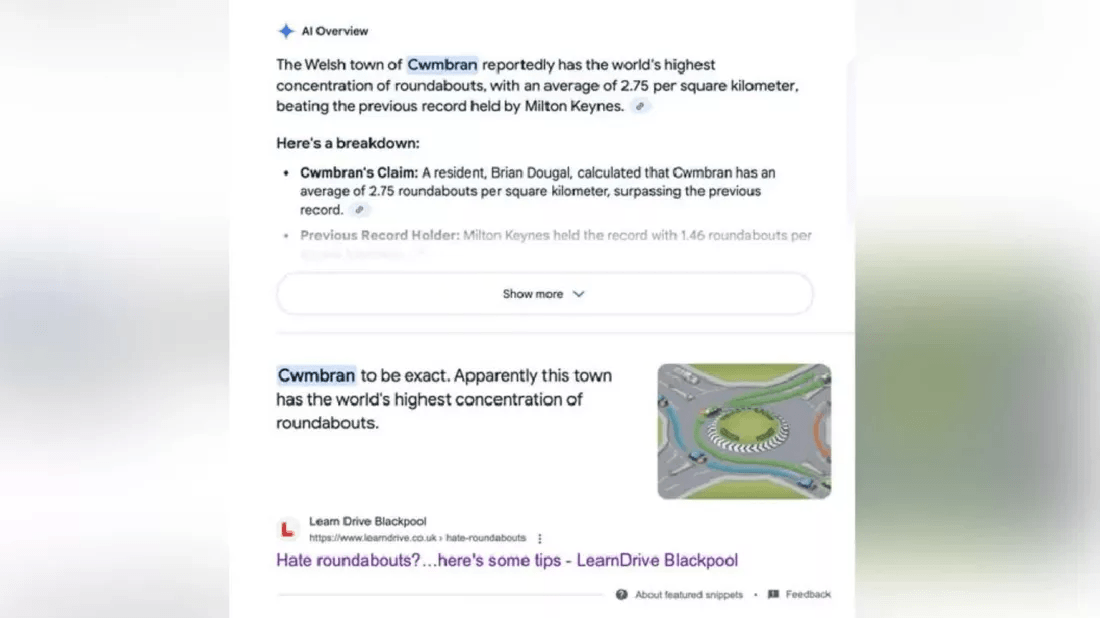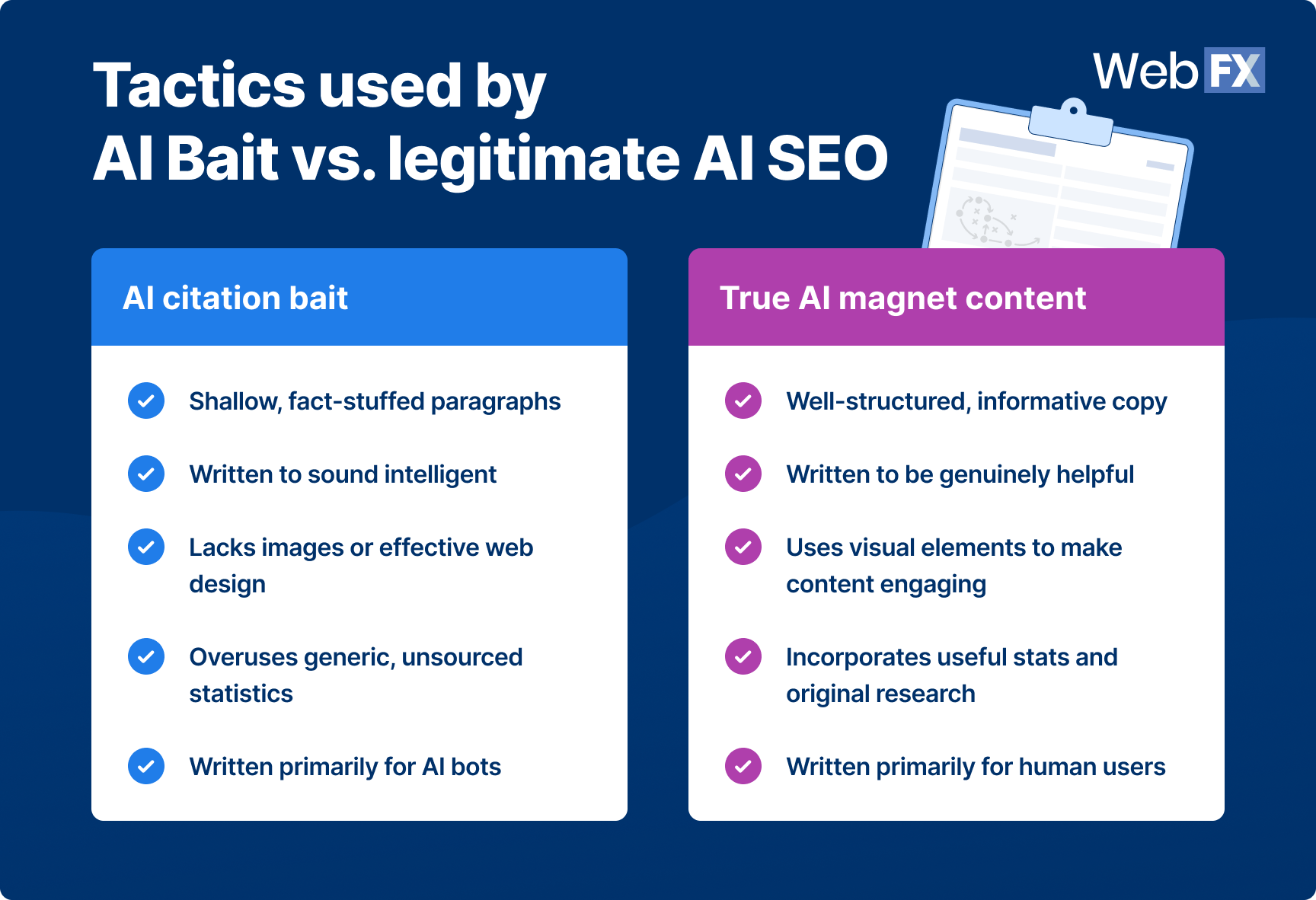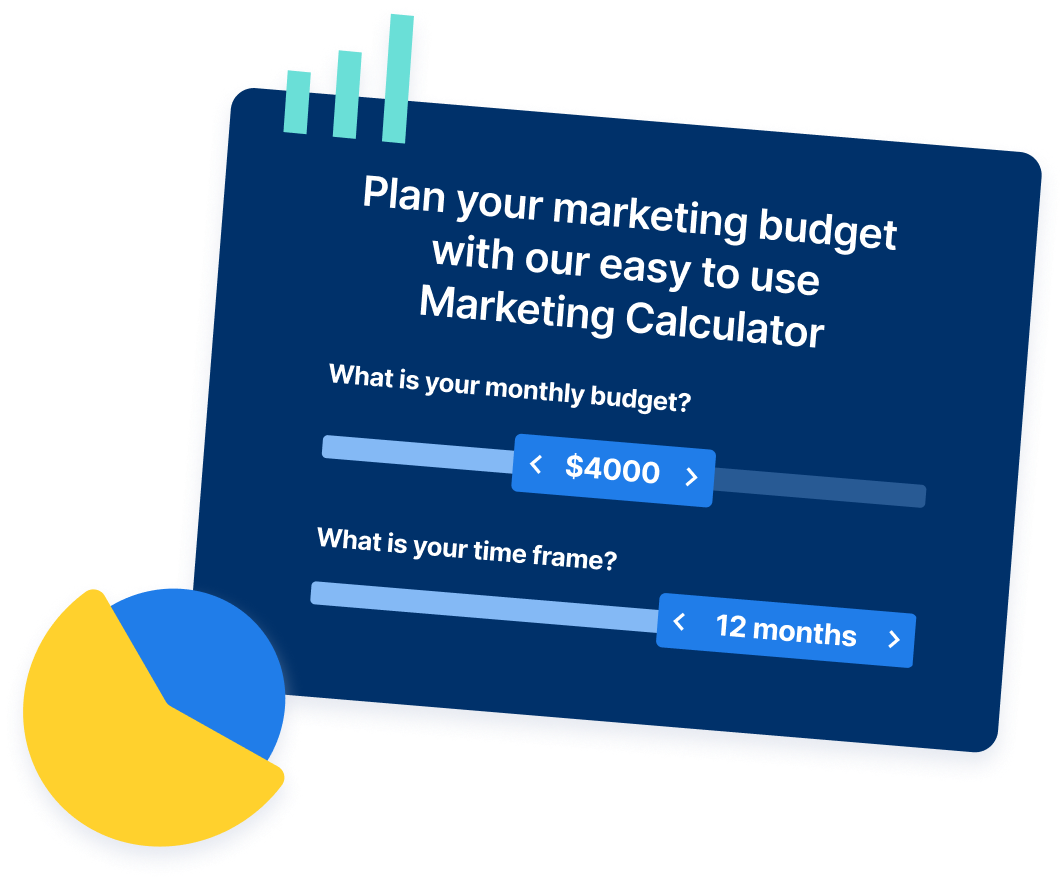-
 Published: Aug 1, 2025
Published: Aug 1, 2025
-
 7 min. read
7 min. read
-
Summarize in ChatGPT
-
 Matthew Gibbons
Matthew Gibbons Senior Data & Tech Writer
Senior Data & Tech Writer
- Matthew Gibbons is a Senior Data & Tech Writer at WebFX, where he strives to help businesses understand niche and complex marketing topics related to SEO, martech, and more. With a B.A. in Professional and Public Writing from Auburn University, he’s written over 1,000 marketing guides and video scripts since joining the company in 2020. In addition to the WebFX blog, you can find his work on SEO.com, Nutshell, TeamAI, and the WebFX YouTube channel. When he’s not pumping out fresh blog posts and articles, he’s usually fueling his Tolkien obsession or working on his latest creative project.
Table of Contents
- From crawled to chosen: The rise of agentic discovery
- Why AI bait is risky: The April Fools’ incident that fooled Google AI
- 3 ways AI bait falls short in 2025
- What AI agents actually prioritize
- AI bait vs. true AI magnet content
- How to get your content chosen by AI
- Future-proof your content strategy in the new age of AI
Key Takeaways
- AI citation bait is outdated and risky: Strategies that once “tricked” AI into citing shallow, stat-stuffed content don’t work in the age of agentic search.
- Getting cited isn’t enough: Modern AI agents evaluate content in real time, deciding what to trust, summarize, and feature. But mentions alone won’t drive traffic. If your content doesn’t give users a reason to click further, you’ve been cited without impact.
- Human-first content wins in AI search: To show up in agentic search, create content that directly answers user intent, demonstrates experience, and is structured for both users and AI agents.
The launch of agent-based browsing from ChatGPT and Perplexity’s new Comet browser mark a turning point in how AI platforms evaluate and cite content.
Instead of blindly scraping text, today’s AI systems behave more like humans: Navigating websites, comparing sources, and choosing content based on depth, clarity, and user experience.
If your content reads like it was written for a machine with short, stat-stuffed paragraphs or rehashed definitions, it’s time to rethink your strategy.
In this article, we’ll break down:
- The rise of agentic discovery
- Why AI bait falls short
- What AI agents actually prioritize
- AI bait vs. true AI magnet content
- How to get your content chosen by AI
From crawled to chosen: The rise of agentic discovery
In the early days of LLMs, “AI bait” — pages designed to be scraped, not read — may have worked.
This content often includes:
- Shallow, statistic-stuffed paragraphs
- Overused jargon meant to impress machines
- Definition-style explanations that regurgitate common knowledge
- Lack of perspective or originality
- No clear author or source signals
While AI bait may have tricked early models, today’s AI systems operate differently. We’ve entered the age of agentic discovery, where tools don’t just surface content. They choose what to trust, summarize, and cite.
Why AI bait is risky: The April Fools’ incident that fooled Google
Here’s a quick example you may have seen earlier this year.
When a Welsh journalist behind the news site Cwmbran Life made up a fake story for April Fools’ Day, he was shocked to see it cited by Google’s AI Overview.

Google’s AI Overview used the satirical article, which claimed the town of Cwmbran has the world’s highest concentration of roundabouts, as the basis for its answer.
While harmless in this case, it’s a clear example of how quickly misinformation can spread when AI systems rely on surface-level signals instead of context and credibility.
This is exactly the kind of scenario that agentic discovery aims to avoid. Browsing agents and smarter systems are being trained to read between the lines to avoid surfacing content that’s misleading or lacks real-world credibility.
3 ways AI bait falls short in 2025
Here are a few key ways AI bait misses the mark:
I’ll get deeper into the details below.
1. Modern AI agents act more like humans
Launched earlier this month, ChatGPT agent and Perplexity’s Comet browser give a glimpse into the future of AI search.
These aren’t just new upgrades. They represent a larger shift in how AI search works on a fundamental level. Rather than simply scraping content, these new systems evaluate and select content similar to how a user would.
Comet and ChatGPT agents browse the web in real time, weighing context, clarity, and relevance. That means old-school tricks no longer work.

Table View ⬇️
| Era | Optimized For | Success Looked Like |
| Traditional SEO | Search engines | Rankings, blue link clicks |
| AI citation bait (2023) | LLMs (hallucination scraping) | Citation text in AI responses |
| Agentic AI Era (2024+) | Human users via AI agents | Selection, trust, user retention |
Going forward, the question isn’t, “Can I get cited by AI tools?” Instead, it’s “Would an AI acting on a user’s behalf choose my content?”
2. Citations don’t equal clicks
Remember, just because an AI tool mentions your content doesn’t mean people are visiting your site.
AI responses often paraphrase or summarize what you write, strip away the nuance, and deliver it directly in search results — no clicks required.
Google’s AI Overviews are a perfect example. Here are a few things they’ve been known to do:
- Cite a brand without linking to it
- Cite a cluster of sites without favoring any one source
- Not cite anyone at all (especially for common knowledge or surface-level content)
According to Pew Research, 88% of AI Overviews cite three or more sources, with only 1% citing a single source.
If your entire strategy hinges on “being a source,” but there’s no reason for the user to dig deeper, you’ve essentially created invisible content with little measurable business value.
3. AI bait erodes human trust
Content optimized only for AI often reads like it was built in a lab, not written by a subject-matter expert.
Even if AI bait earns a temporary citation, it creates a long-term trust problem. When real users land on the page, whether from a link or through branded search, they’ll skim a few lines, realize there’s nothing valuable, and leave.
Optimizing only for AI citations may result in content that ranks but doesn’t convert, gets paraphrased without credit, and ultimately damages your brand’s credibility.
What AI agents actually prioritize
AI agents don’t just scrape. They’re designed to find fast, clear, trustworthy content that solves users’ problems.
Here’s what AI agents look for:
|
Signal |
Why It Matters |
| Topical clarity | Matches search intent quickly |
| Structured layout | Easy to parse, extract, and summarize |
| Credible sourcing | Reinforces trust in answers |
| Experience-driven insight | Adds unique value vs. generic info |
| UX and load speed | Improves usability for agent and user alike |
AI bait vs. true AI magnet content
Here’s a breakdown that shows the major practical differences between AI bait and content that earns AI citations the right way:

Table View ⬇️
| AI Citation Bait | True AI magnet content |
| Shallow, fact-stuffed paragraphs | Well-structured, informative copy |
| Written to sound intelligent | Written to be genuinely helpful |
| Lacks images or effective web design | Uses visual elements to make content engaging |
| Overuses generic, unsourced statistics | Incorporates useful stats and original research |
| Written primarily for AI bots | Written primarily for human users |
Modern agentic platforms reward content designed for humans, not machines. These tactics will help you create content that’s clear, concise, and helpful for users, enabling you to get discovered by AI and drive traffic and conversions.
How to get your content chosen by AI
Let’s break down some practical ways to get your content chosen by AI in the new era of search:
- Focus on helpful, human-centered answers
- Incorporate visuals that support clarity
- Demonstrate human experience with E-E-A-T
- Cite credible data sources (and original research)
- Use schema markup to help AI agents understand content
Let’s look at how each of those methods can improve your AI SEO.
1. Focus on helpful, human-centered answers
AI agents help users solve problems and complete tasks.
Focus on directly answering search intent, and go beyond surface-level definitions. Answer the user’s question, add context, explain why it matters, and give an expert perspective beyond what AI traditionally summarizes.
2. Incorporate visuals that support clarity
AI agents are increasingly capable of parsing visual context (like charts or labeled images), and they prefer content that enhances user understanding. Custom graphics, screenshots, and tables aren’t just for decoration. They add clarity and create meaningful interactions with users.
3. Demonstrate human experience with E-E-A-T
E-E-A-T matters more than ever. Cite firsthand knowledge, include author bylines, share original insights, and link to real-world examples. These cues signal trust and authority to both users and AI systems.
4. Cite credible sources (and original research)
Tossing in random stats used to fool AI models, but not anymore. Use relevant, up-to-date, and properly cited data (bonus points if it’s original research). AI agents look for originality and trust signals over filler.
5. Use schema markup to help AI agents understand content
Structured data helps both traditional search engines and AI agents understand your content, not just crawl it. Add some FAQs and How-To schema to highlight key information.
Future-proof your content strategy in the new age of AI
Want to make sure your content gets chosen, not just crawled?
WebFX has been optimizing for AI-driven discovery since day one. Whether you’re refreshing existing content or building a human-first strategy from scratch, we can help.
Explore our AI SEO services or contact us online to get started!
-
 Matthew Gibbons is a Senior Data & Tech Writer at WebFX, where he strives to help businesses understand niche and complex marketing topics related to SEO, martech, and more. With a B.A. in Professional and Public Writing from Auburn University, he’s written over 1,000 marketing guides and video scripts since joining the company in 2020. In addition to the WebFX blog, you can find his work on SEO.com, Nutshell, TeamAI, and the WebFX YouTube channel. When he’s not pumping out fresh blog posts and articles, he’s usually fueling his Tolkien obsession or working on his latest creative project.
Matthew Gibbons is a Senior Data & Tech Writer at WebFX, where he strives to help businesses understand niche and complex marketing topics related to SEO, martech, and more. With a B.A. in Professional and Public Writing from Auburn University, he’s written over 1,000 marketing guides and video scripts since joining the company in 2020. In addition to the WebFX blog, you can find his work on SEO.com, Nutshell, TeamAI, and the WebFX YouTube channel. When he’s not pumping out fresh blog posts and articles, he’s usually fueling his Tolkien obsession or working on his latest creative project. -

WebFX is a full-service marketing agency with 1,100+ client reviews and a 4.9-star rating on Clutch! Find out how our expert team and revenue-accelerating tech can drive results for you! Learn more
Try our free Marketing Calculator
Craft a tailored online marketing strategy! Utilize our free Internet marketing calculator for a custom plan based on your location, reach, timeframe, and budget.
Plan Your Marketing Budget
Table of Contents
- From crawled to chosen: The rise of agentic discovery
- Why AI bait is risky: The April Fools’ incident that fooled Google AI
- 3 ways AI bait falls short in 2025
- What AI agents actually prioritize
- AI bait vs. true AI magnet content
- How to get your content chosen by AI
- Future-proof your content strategy in the new age of AI

SEO Success with KOA

Proven Marketing Strategies
Try our free Marketing Calculator
Craft a tailored online marketing strategy! Utilize our free Internet marketing calculator for a custom plan based on your location, reach, timeframe, and budget.
Plan Your Marketing Budget
What to read next




